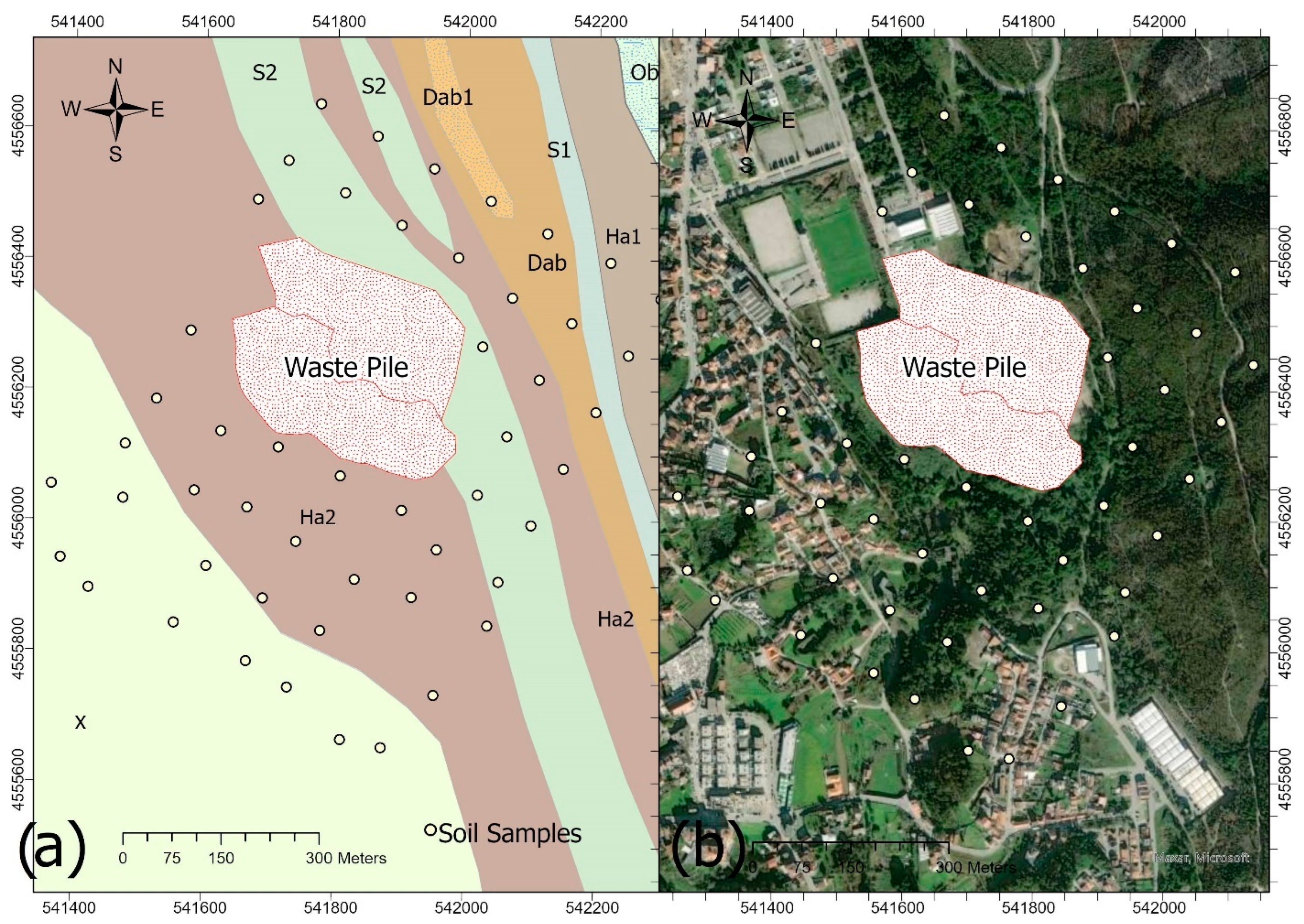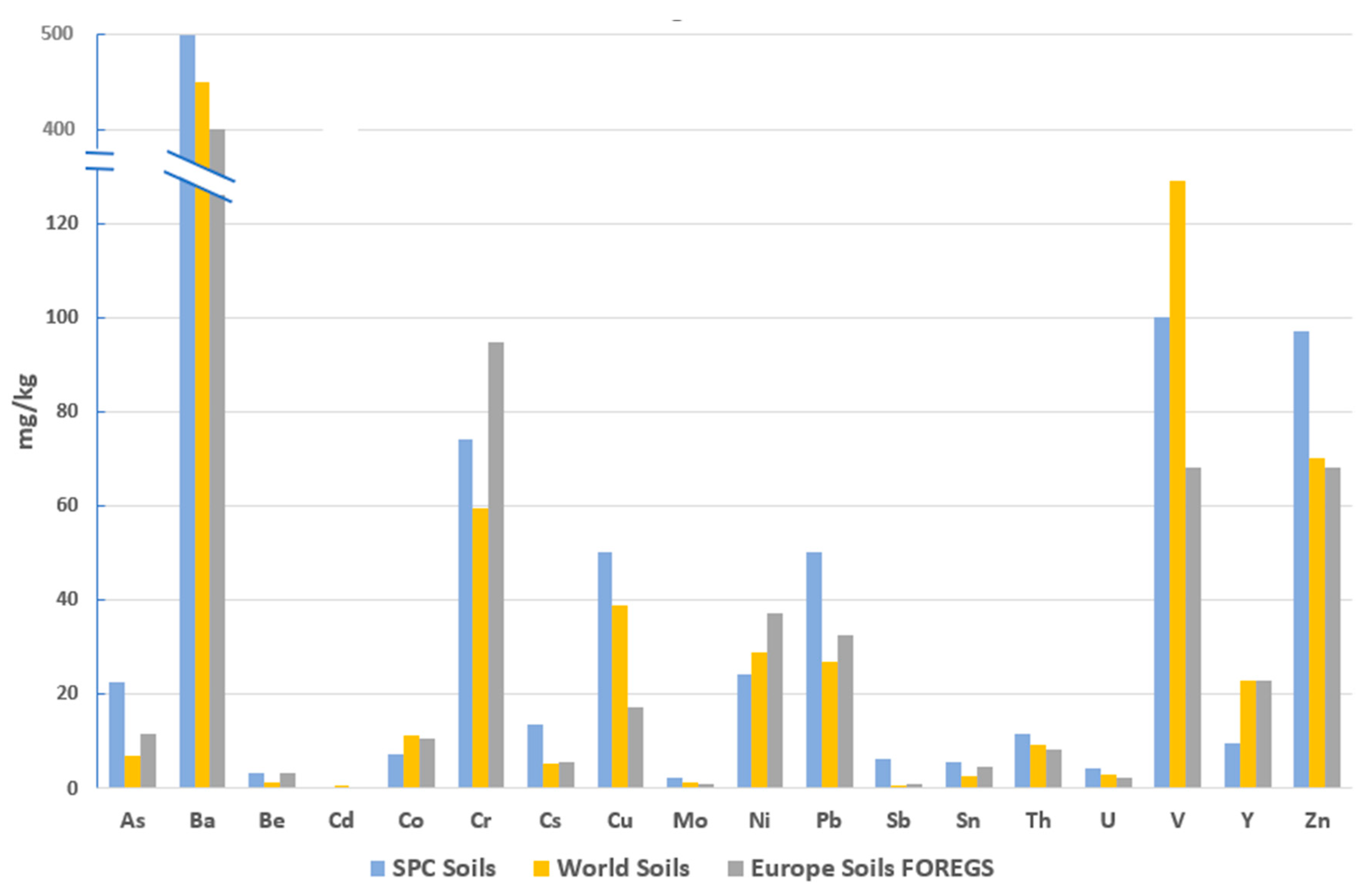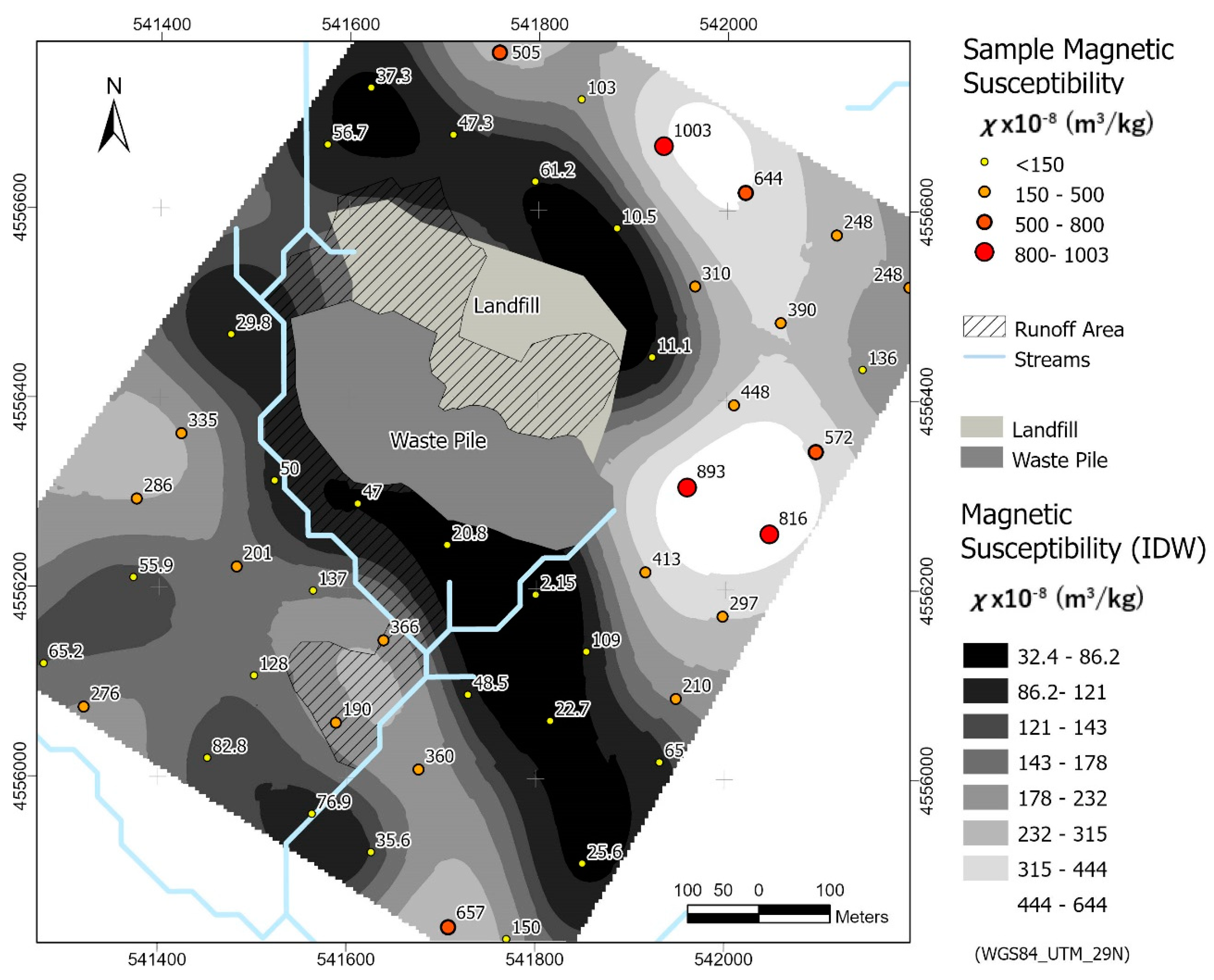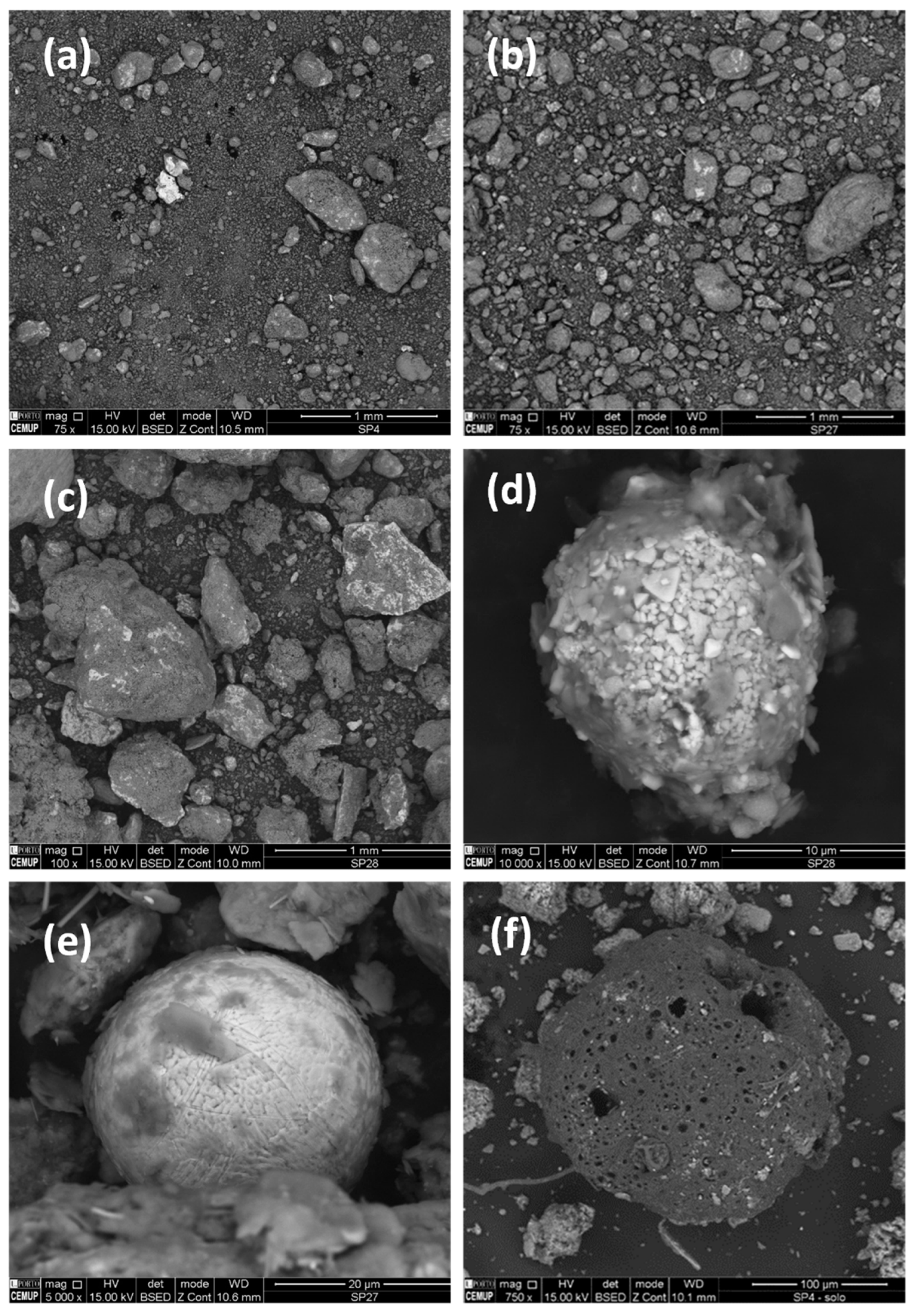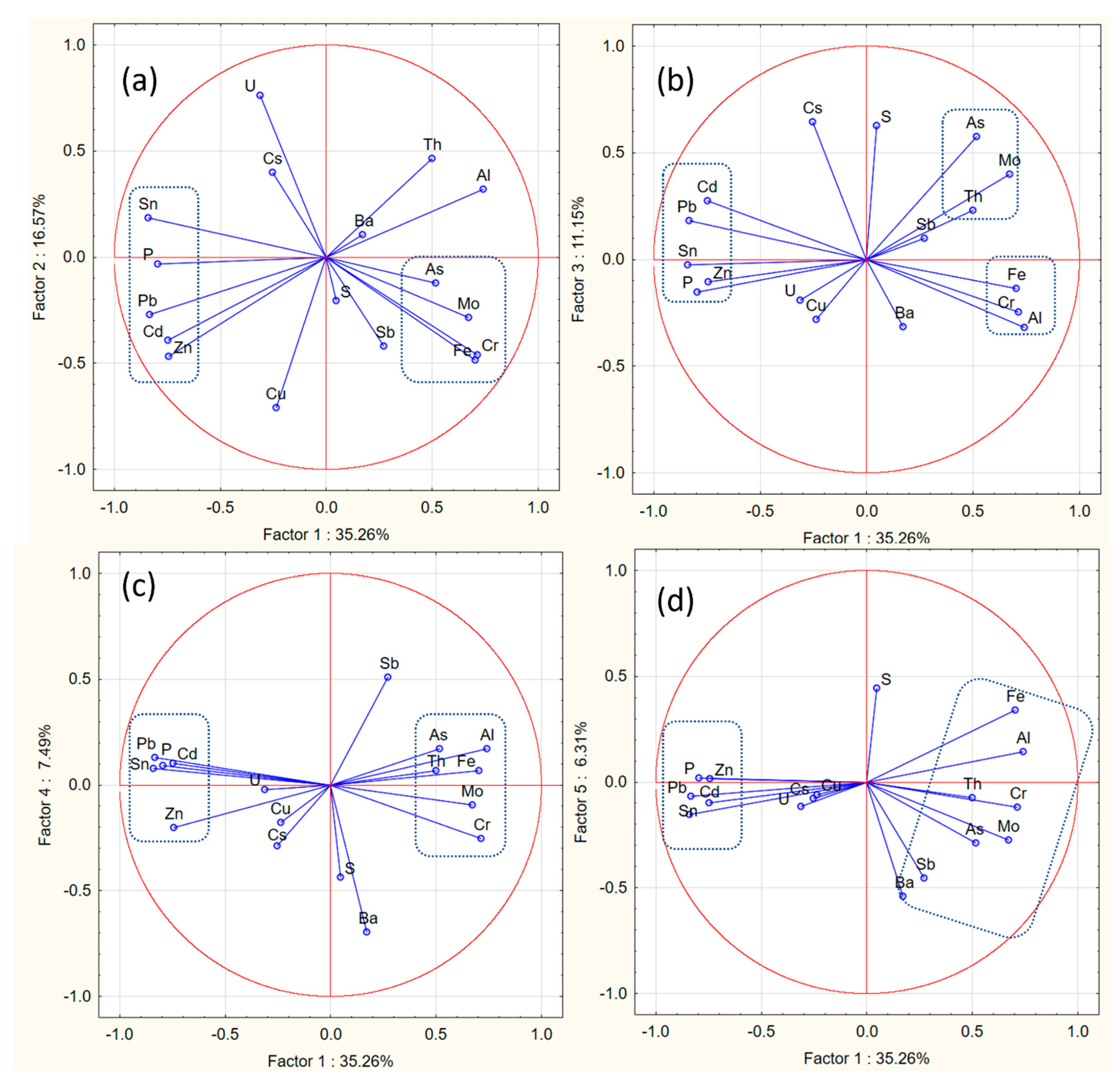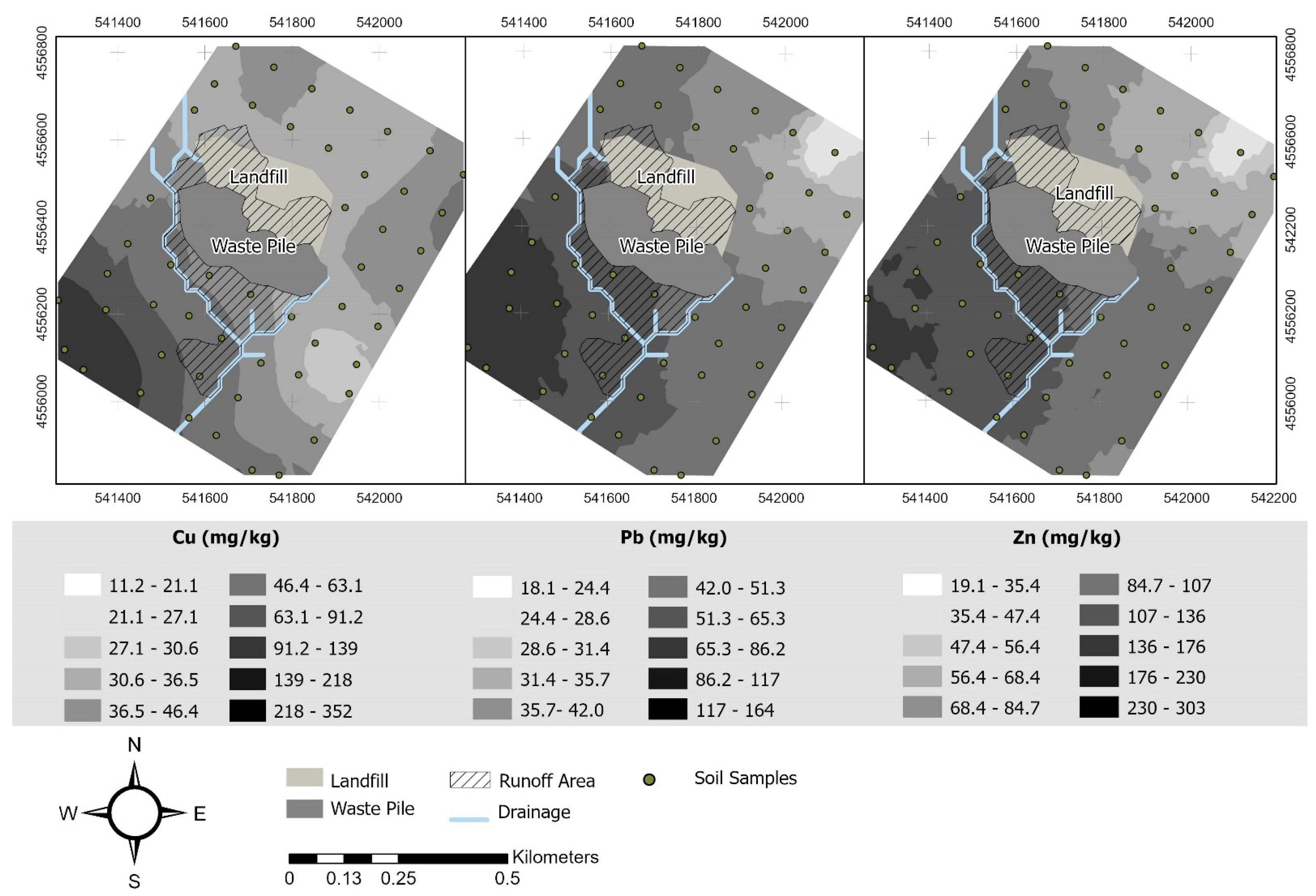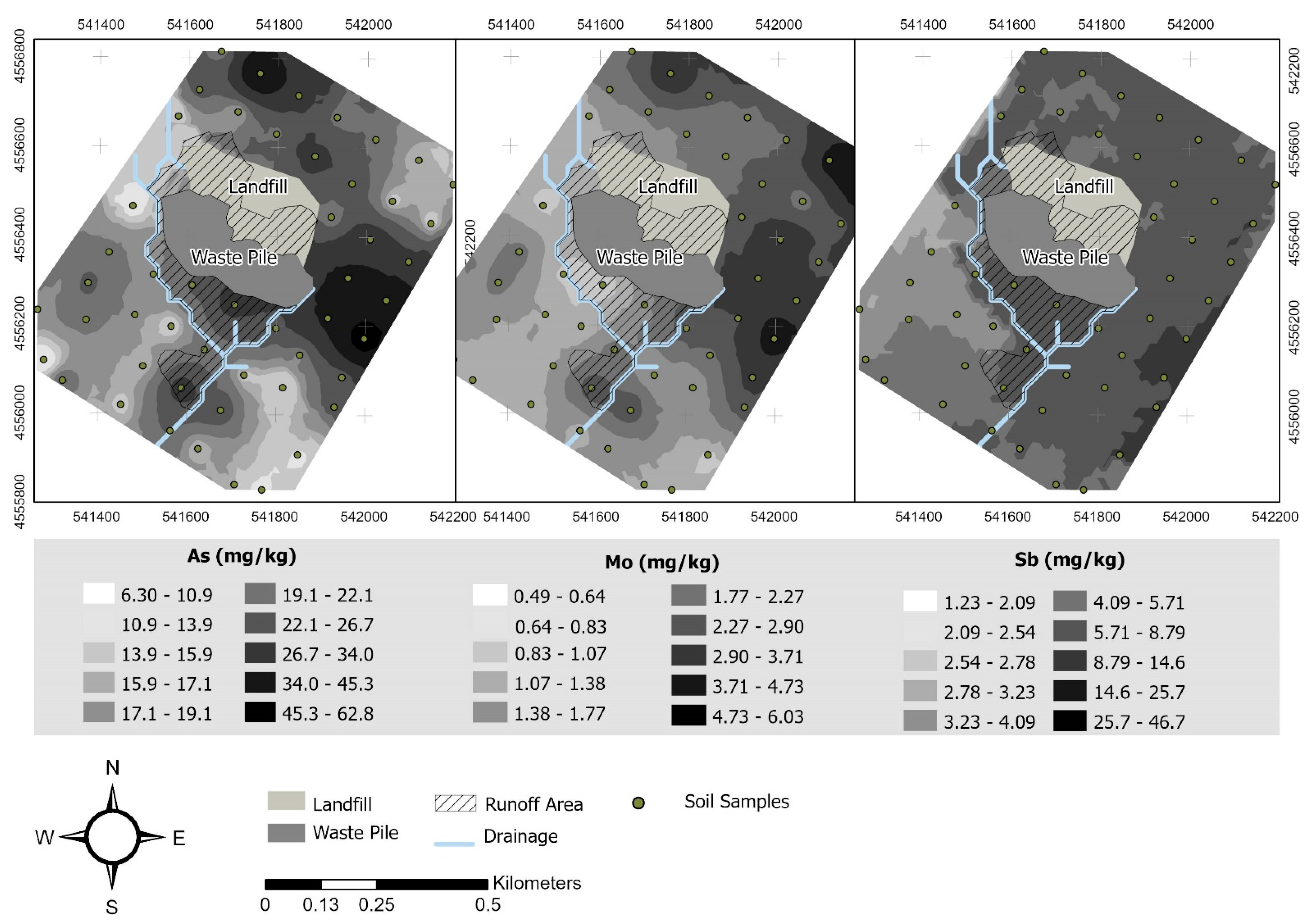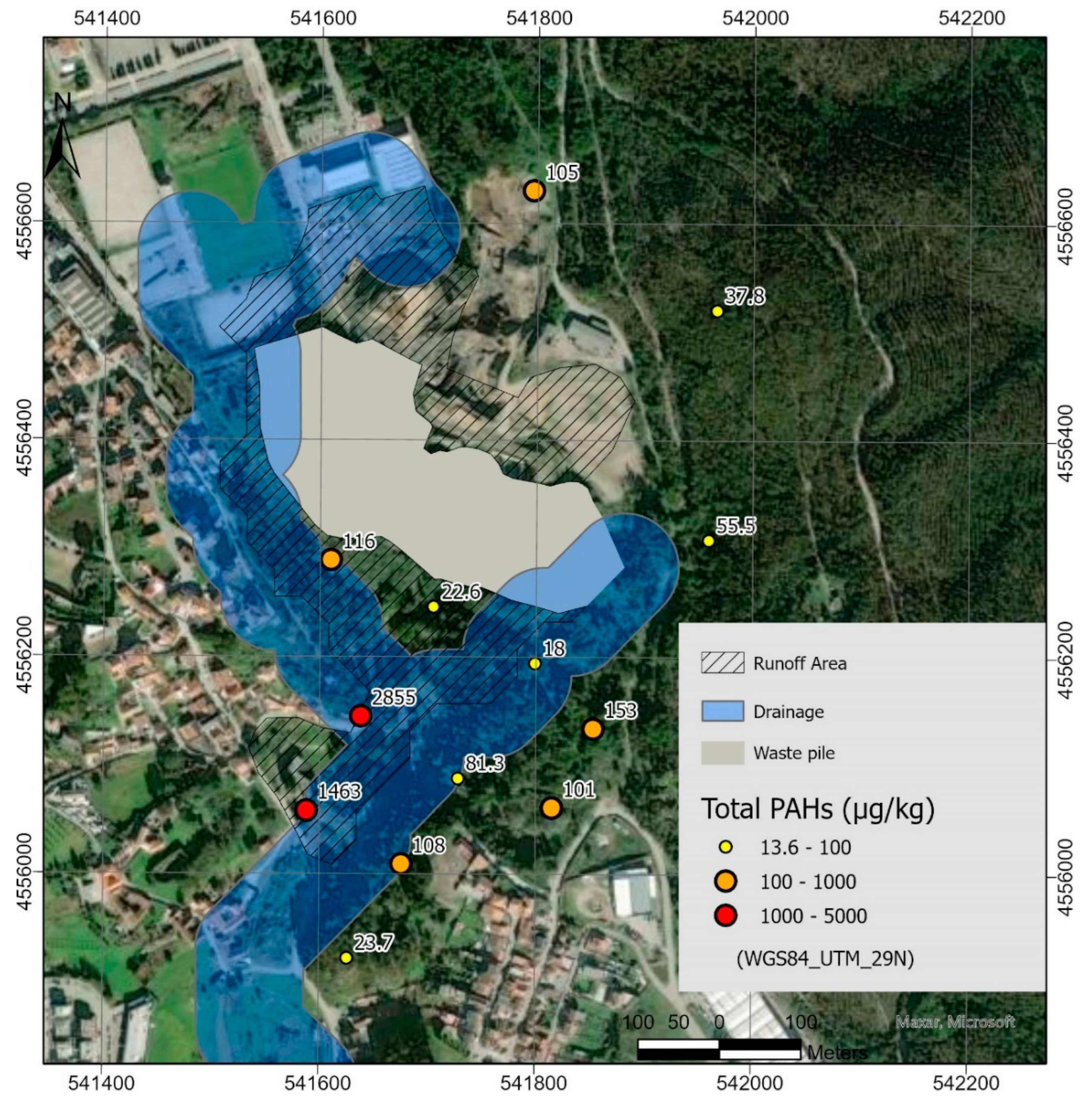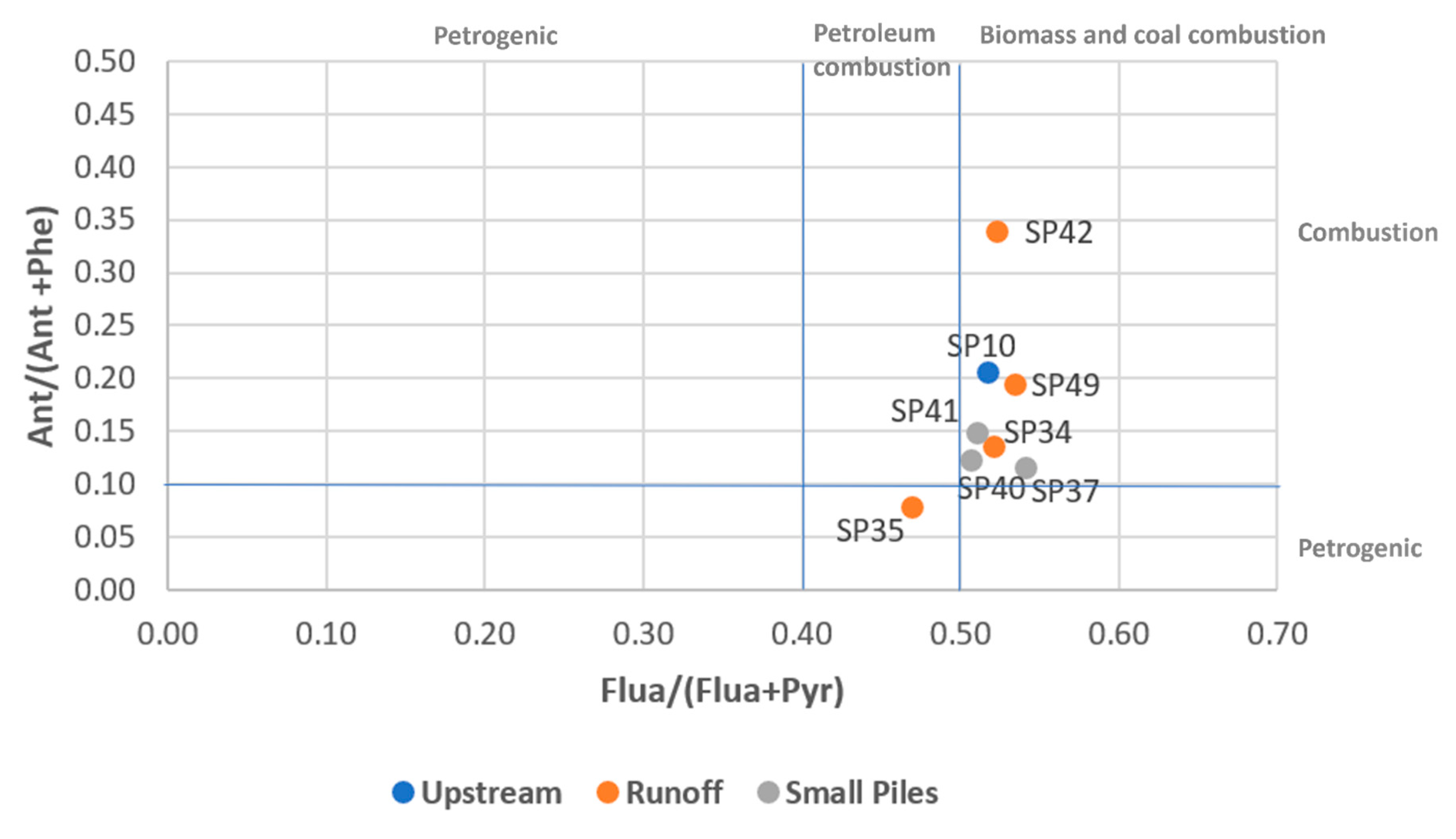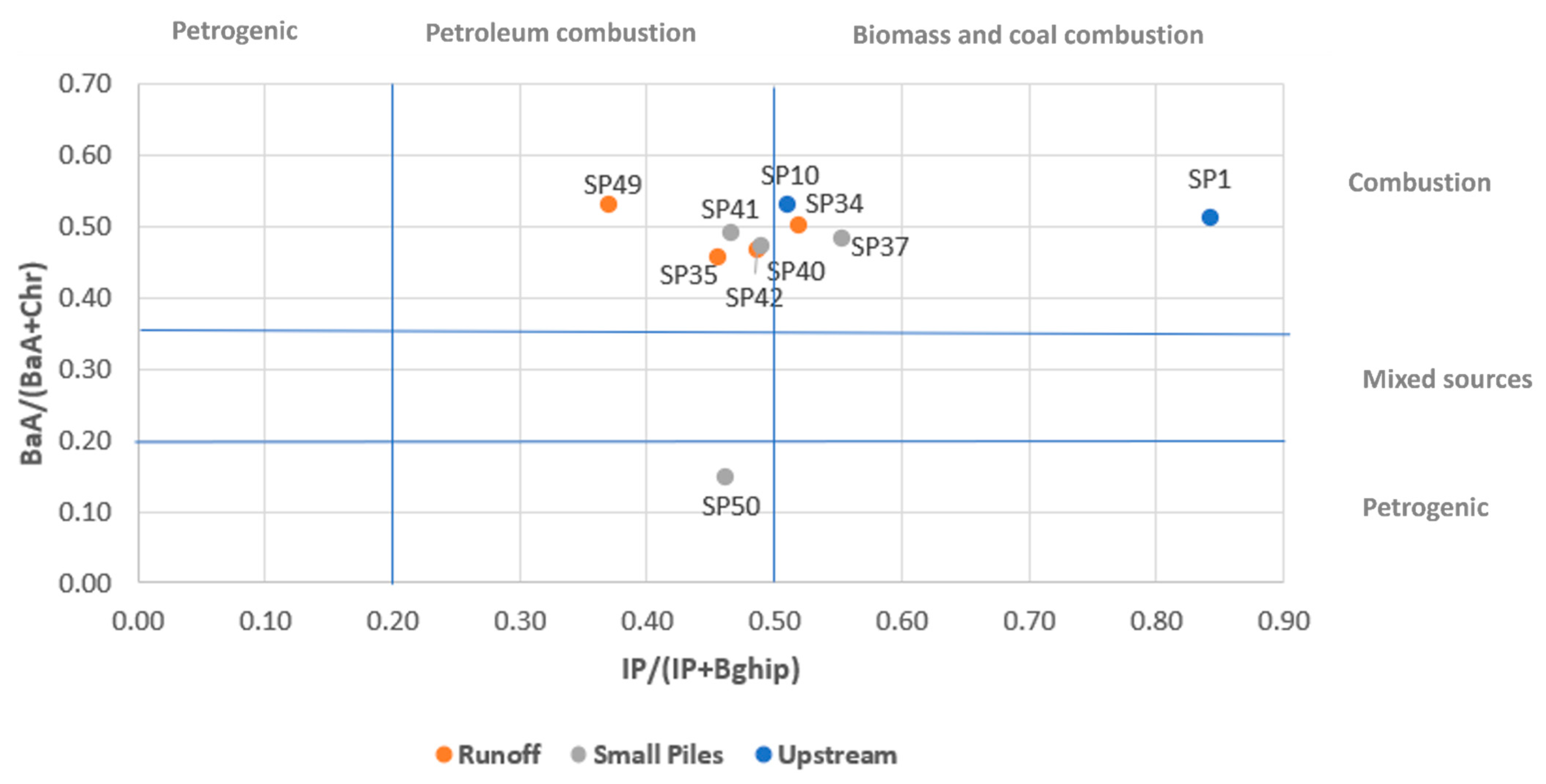3.1. General Soil Geochemical Characterization
The 50 soil samples collected surrounding the mine were submitted to ultimate analysis for determination of C, H, N, S by CHNOS analyser and analysed by ICP-ES/MS for major and trace elements (
Table 2).
Regarding the mean values of the analysed elements present in the samples, the soils are composed (in decreasing proportions) of Al > C > Fe > K > H > Na > N > Ti > Mg > Ca > P > S. Most major elements showed a coefficient of variation (CV) lower than 100%, indicating overall low variability on the data, the elements that present the highest variability are Ca, C and S.
The mean concentrations of trace elements measured in soils followed a descending order as Ba > Mn > ∑LREE > V > Zn > Cr > Pb > Cu >∑HREE > Ni > As > Cs > Th > Y > Co > Sb >Sn > U > Be > Mo > Cd. Skewness values showed that, in general, trace elements data are positively skewed, with tail of distribution towards higher concentrations (except for Th and V) and kurtosis is predominantly leptokurtic (except V), moving away from a normal distribution pattern. The distribution of the data set was evaluated using Shapiro–Wilk’s methods (
p < 0.05), which confirmed that the majority of the elements from
Table 2 are not normally distributed (exceptions for N, H, K, Al, and Th).
The soils present generally higher content in Mn than the mining wastes, with a mean value of 174 mg/kg, given that the average values measured in wastes were 51.3 and 65.0 mg/kg, respectively, in the unburned and the burned areas [
14]. The soils also show slight increase of Co, Cu, Pb, Zn, and HREEs when compared with averaged waste pile material samples, suggesting that the soil may have been concentrating these elements or that they may have been supplied by different sources.
Regarding the concentrations of hazardous elements, their concentrations in soils were compared with the Portuguese soil contamination reference values [
22] and with the Canadian guidelines [
24] for agriculture soils.
Considering the Portuguese guidelines, all soil samples showed contamination in Sb. In this case, the maximum Sb concentration (46.7 mg/kg) is 46 times higher than the reference value.
Barium concentration in all samples was also above the Portuguese reference value of 210 mg/kg with a maximum of 1489 mg/kg (7 times above the reference). However, considering the Canadian guidelines for Ba, the proposed maximum soil quality threshold for Ba is significantly higher (750 mg/kg). Therefore, the average concentration in soils lies within the suggested ranges, with only two soil samples exceeding this limit. Additionally, the Ba concentrations in the soils from the surrounding area of the coal mine are similar to the concentrations present in world soils [
24] and European soils [
23]. The average U concentration in these soils is 4.24 mg/kg and all samples exceed the Portuguese reference value (1.90 mg/kg) up to a maximum of 11.0 mg/kg (maximum concentration 7 times higher than the Portuguese limit). Nevertheless, in comparison with the Canadian Guidelines from [
24], all samples show U concentration below the reference value (23 mg/kg) When compared to the national [
23] and Canadian guidelines [
24], over 90% of the samples have As concentrations above the reference values of 11 and 12 mg/kg, respectively, with maximum values reaching 62.8 mg/kg (about 6 times higher than the reference values).
In 74% of the samples, the V concentration is above the Portuguese reference, and only 30% of the samples this concentration is above the reference value proposed by the Canadian guidelines.
Regarding the Be concentrations in the soils, 68% of the samples presented concentrations above the Portuguese reference value of 2.5 mg/kg, up to a maximum of 3.26 mg/kg.
Considering the Cr levels, 62% of the soils are above the regulated threshold values in Portugal (67 mg/g) and 70% of the samples present grades higher than the Canadian reference value (64 mg/kg), up to a maximum of 209 mg/kg.
There were 42% of samples exceeding the Mo value proposed by the Portuguese soil guideline of 2 mg/kg, up to a maximum of 6.03 mg/kg.
As for Pb, 42% of the soil samples showed concentrations above the Portuguese reference value of 45 mg/kg. However, only 18% of the samples exceed the value proposed by the Canadian guideline (70 mg/kg) to a maximum of 164 mg/kg.
In the case of Cu, 16% of the samples presented concentrations above the reference value proposed of 62 mg/kg and 63 mg/kg by the Portuguese and Canadian guidelines, respectively.
There were 14% of soil samples with Ni concentrations above the Portuguese reference value (37 mg/kg) and only one sample exceeding the Canadian legislation.
Six percent of the soil samples have Co concentrations above the Portuguese reference value (19 mg/kg), up to a maximum of 32.6 mg/kg.
The average concentration of Zn in these soils was significantly lower than the reference values. Only 2% of the samples showed concentrations above the reference value proposed by APA (290 mg/kg). While in what concerns the Canadian guidelines, 10% of the soil samples have concentrations higher than the reference value proposed (200 mg/kg).
All Cd levels fall below the reference values for contaminated agricultural soil provided by APA and CCME.
Major elements concentration values in the São Pedro da Cova soils are similar to the EuroGeoSurveys-FOREGS geochemical baseline provided for European Soils [
23], pointing to a slight decrease in Ca, Mg, Na, P, and Ti.
Figure 2 presents a comparison of the trace element concentrations in the soils of the study area and European topsoils from the Geochemical Atlas of Europe [
23] and average concentrations of trace elements in world surface soils [
24].
The concentration of trace elements in the studied soils points to higher concentrations of As, Cs, and Sb, with average values of 22.6, 13.6, and 6.29 mg/kg, respectively, when compared to (1) European topsoils [
23] with 11.6, 5.58 and 1.04 mg/kg, respectively, and (2) the world soils [
24], with average concentration of As, Cs, and Sb of 6.83, 5.06, and 0.67 mg/kg. Other trace elements, such as Mo, Be, Cu, Pb, Zn, Sn, Th, and U, also show higher concentrations in São Pedro da Cova, than other topsoils in Europe [
25] and worldwide [
26] (
Figure 2).
Given the coal fire that has been active for 17 years in the waste pile of the São Pedro da Cova mine, probably leading to a migration of atmospheric contaminants, the concentrations of nine PTEs present in the soils surrounding the mine, were also compared with the concentrations of trace elements identified in the vicinity of coal-fired power generation centres from different parts of the world [
7,
27,
28,
29,
30]. These soils were also compared with the composition of the fly ash resultant from Tapada do Outeiro coal power production, where the Douro coalfield coal (including the one providing from São Pedro da Cova mine) was burned (
Table 3).
The As concentrations in the studied soils, range from 6.30 to 62.8 mg/kg and are similar to the As present in fly ash from Tapada do Outeiro (whereas concentrations range from 28–82 mg/kg). However, in general, the As content is higher than in the soils from the vicinity of other power plants worldwide.
The concentrations of Cu, Pb, and Zn measured in São Pedro da Cova soils, can reach maximum values of 352 mg/kg, 164 mg/kg, and 303 mg/kg, respectively. These values are significantly higher than the concentrations determined in the waste pile, and higher than the Tapada do Outeiro fly ash, which may indicate that other sources of metals may be contributing to the system.
3.3. Soil PAHs Characterization
The concentration of the 16 priority PAHs in 15 soil samples surrounding the main waste pile in the São Pedro da Cova are presented in
Table 7.
The priority PAHs sums varied at different sampling locations (
Figure 10). The samples located upstream of the waste pile, in forest areas, presented a total of the 16 priority PAHs, ranging from 13.6 µg/kg to 55.5 µg/kg, with one sample (SP10) presenting a higher sum of 105.3 µg/kg (this sample may, however, be affected by the steel industry residues deposited, since it is located along the northern border of the landfill).
The samples collected along the runoff, contiguously to the main waste pile, presented a sum of the 16 PAHs on the two samples immediately downstream of the waste pile (22.6 and 116 µg/kg), while two other samples located further downstream registered higher sums of the priority PAHs, 2855 µg/kg (SP42) and 1463 µg/kg (SP49). These greater concentrations seem to be related to the material deposited directly in soils as a result of centuries of mining since the first sample is located next to the mine shaft elevator and the second outside of the old mine processing facilities. The dominant PAH in these samples is benzo[b]fluoranthene, ranging from 4.29 to 615 µg/kg.
A Shapiro–Wilk test was performed, showing that the distribution of the sum of priority PAHs departed significantly from normality (W = 0.47, p-value < 0.01). Based on this outcome, a non-parametric Kruskal–Wallis Test was conducted to examine the differences on the sum of the 16 PAHs in samples collected upstream of the waste pile, along its runoff area and in areas upstream with influence from minor coal mining waste deposits. No significant differences were found (Chi-square = 2.75, p = 0.25, df = 2).
Samples collected upstream of the mine main waste pile, but potentially influenced by minor mining waste deposits, presented a sum of the 16 priority PAHs that ranged from 18.0 to 153 µg/kg, with median sum values of 91.0 µg/kg.
In general, the samples collected upstream in the forest region, NE of
Figure 10, with no influence from the mining wastes, presented less variability of the 16 priority PAHs. The median value of the sum of the 16 PAHs is 37.8 µg/kg, ranging from 13.6 and 55.5 µg/kg.
The values of the samples included in the waste pile runoff area present a median sum of priority PAHs of 69.2 µg/kg and 789 µg/kg when the two samples collected near the mining facilities are included.
The results were compared to the Portuguese reference values for soil contamination, regarding agriculture purposes, suggested by the Portuguese Environmental Agency (APA) [
23]. All samples presented concentrations for the 16 priority PAHs below the reference values proposed, except samples SP42 and SP49. The first one exceeds the Portuguese reference values for anthracene and all the HMW PAHs (High Molecular Weight PAHs, containing 2 to 3 rings) analysed, except dibenz[ah]anthracene and benzo[ghi]perylene. The concentrations of pyrene and benzo[b]fluoranthene overcome the soil contamination threshold, by more than twice the value proposed by APA, as benzo[a]anthracene and benzo[a]pyrene concentrations are three times higher than the reference value and benzo[k]fluoranthene concentration is five times higher than the proposed reference value.
In sample SP49, the concentrations of benzo[a]anthracene, benzo[a]pyrene, and benzo[k]fluoranthene exceed the reference values almost by double. The high concentrations of HMW PAHs (High Molecular Weight PAHs, with 4 to 6 rings) measured, particularly in SP42 and SP49 samples, are significant since benzo[a]anthracene, benzo[b]fluoranthene, benzo[a]pyrene, and benzo[k]fluoranthene are listed as carcinogenic PAHs [
90], and may cause significant damage to the surrounding ecosystems as well as the human health.
Table 8 compiles the LMW and HMW PAHs percentages distributed in the soils upstream of the waste pile, along the runoff areas and influenced by small piles of waste. The samples located along the runoff area present higher proportions of HMW PAHs. On average, these samples include 77% of HMW and only 23% of LMW PAHs, while samples upstream unaffected by the waste pile, and potentially affected by small mining residues piles, seem more balanced, with LMW PAHs average contributes of 48% and 40% to total PAHs, respectively.
The ratio of LMW to HMW PAHs can be an expedient manner to infer if the sources of PAHs are petrogenic or pyrogenic [
48,
49]. If the LMW PAHs are the majority, it indicates that the PAHs are mainly petrogenic, otherwise, if HMW PAHs are higher than LMW PAHs, the sources are pyrogenic, mostly combustion reactions [
91,
92,
93].
The soils from the surrounding area of the São Pedro da Cova mine show a clear predominance of HMW PAHs (
Table 8), which tend to increase particularly along the waste pile runoff area, which points to a pyrogenic origin, possibly related to the self-combustion that has been occurring since 2005 in the waste pile. Previous studies concluded that the waste pile affected materials by self-burning showed greater concentration and variety of PAHs in the soil horizons with higher self-burning temperature, where HMW PAHs were dominant [
16,
20]
Diagnostic isomer ratios of PAHs can be used to identify the possible emission sources due to the different ratios produced by the multiple sources. In this study, four specific PAHs ratios were used to analyse the source of these PAHs and to distinguish between petrogenic and pyrolytic sources: BaA/(BaA + Chr), Ant/(Ant + Phe), Flua/(Flua + Pyr), and IP/(IP + Bghip) [
93].
The ratio of Ant/(Ant + Phe) < 0.1 and Flua/(Flua + Pyr) < 0.4 suggests a petrogenetic source, while Ant/(Ant + Phe) ratio > 0.1 and Flua/(Flua + Pyr) > 0.4 points to combustion or pyrogenic sources. If Flua/(Flua + Pyr) is between 0.4 and 0.5 may imply liquid fossil fuel combustion and if Flua/(Flua + Pyr) is higher biomass and coal combustion [
52].
As shown in
Figure 11, most of the studied samples seem to have PAHs with combustion origins, and only in one sample (SP35) the PAHs source is classified as petrogenic by the Ant/(Ant + Phe) ratio. According to the ratio Flua/(Flua + Pyr), samples SP35 and SP12 described in
Table 8, may potentially result from liquid fuel combustion. However, in most samples, the PAHs sources are coal and/or biomass combustion.
The ratios IP/(IP + BghiP) and BaA/(BaA + Chr) may be used to characterize the nature of potential PAH emission sources (
Figure 12), while IcdP/(IcdP + BghiP) < 0.2 and BaA/(BaA + Chr) < 0.2 are indicative of petroleum and petrogenic sources. If BaA/(BaA + Chr) ranges between 0.2 and 0.35 and IP/(IP + BghiP) between 0.2 and 0.5, the PAHs usually come from petroleum combustion (liquid fossil fuel, vehicle, and crude oil combustion). If the IP/(IcdP + BghiP) and BaA/(BaA + Chr) ratios are greater than 0.5, the PAHs sources are coal, grass, and wood combustion [
52]. Sample SP50 may be classified as petrogenic (
Figure 12), according to the BaA/(BaA + Chr) ratio.
Considering the results obtained in this study, the PAHs sources in most of the samples were classified as coal or biomass combustion; in one sample, the PAHS are classified as petrogenic sourced, whereas in another sample they have mixed contributions. The ratio IP/(IcdP + BghiP) is slightly disruptive of the previous trends since it indicates petroleum combustion as the PAHs source in 5 samples.
